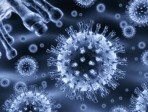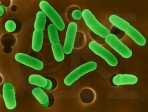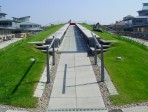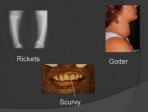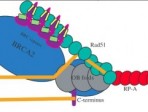 00:09:00
00:09:00
Breast Cancer Susceptibility Gene BRCA2
BRAC2 is a tumor suppressor gene. Its protein product interacts with other proteins to assist regulation of DNA repair, transcription and cell cycle checkpoints. BRAC2 gene disruption may lead to protein truncation, mutations and loss of function. Ce....
More details | Watch now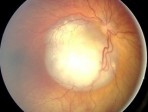 00:05:00
00:05:00
Retinoblastoma
Kyla discusses an overview of the disease, the most common method in which it is diagnosed, as well as the major chemotherapeutics used to treat it.
More details | Watch now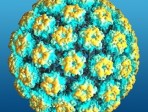 00:12:00
00:12:00
Human Papilloma Virus
The aim of this presentation is to provide an overview of the Human Papilloma Virus (HPV) and the associated carcinogenic pathologies of HPV. The predominant cellular players discussed in HPV pathologies are p53 and viral oncoprotein E6. In addition,....
More details | Watch now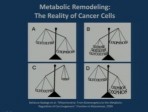 00:10:00
00:10:00
Bioenergetics of Cancer Cells
A brief summary from the literature about cancer cells' metabolism; 1) the major pathways cancer cells use to generate energy and macromolecules efficiently and rapidly and 2) the enzymes cancer cells up-regulate to control those pathways.
More details | Watch now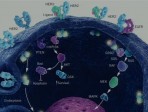 00:08:00
00:08:00
Lapatinib treatment for HER2 Positive Breast Cancer
Discussion on the background information, etiology, and treatment of HER2 positive breast cancer.
More details | Watch now 00:03:00
00:03:00
Microfluidic Biosensor
University of Toronto student Jonathan Yam describes his research on microfluidics during Summer 2010 in the laboratory of Bob Westervelt at Harvard University under the direction of Alex Nemiroski.
More details | Watch now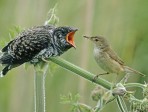 00:06:00
00:06:00
The cuckoo egg mystery
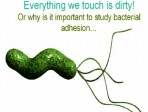 00:16:00
00:16:00
Everything we touch is dirty!
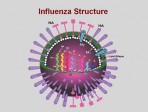 01:05:00
01:05:00
Pandemic Influenza: one flu over the cuckoo’s nest
Where do the pandemic influenza viruses come from and why did experts fail to predict the severity of the 2009 pandemic? However to date, the 2009 H1N1 pandemic influenza has been much less severe than the 1918 Spanish influenza.
More details | Watch now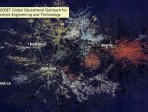 00:31:00
00:31:00
Networks in ecosystems and financial systems
This talk surveys our growing understanding of the relationships between the network structure of ecological networks ? both in mathematical models and in the real world ? and their ability to withstand disturbance, natural or human-created.
More details | Watch now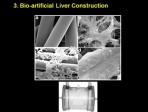 01:04:00
01:04:00
Cloning, stem cells and regenerative medicine
Extraordinary opportunities to study the molecular mechanisms that cause inherited diseases are being provided by new methods of producing stem cells. Hear about not only the potential value of these new methods, but also how their development was pr....
More details | Watch now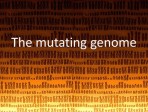 01:06:00
01:06:00
Our genomes, our history
Genetic differences between humans reflect the fundamental processes, such as mutation, recombination and natural selection, which have influenced our evolutionary history. Now that we can chart the genomes of many individuals, we are finding many su....
More details | Watch now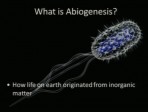 00:10:00
00:10:00
Origin of Life on Earth: Abiogenesis
This presentation portrays a general overview of the theory of abiogenesis and its conceptual history. From the theory of spontaneous generation to biogenesis to the modern-day abiogenesis, the changing perception of the origin of life is discussed.....
More details | Watch now 00:07:00
00:07:00
Cape Gannets
Study on Cape Gannets, a new prey for quickly adapting Great White Pelicans on Malgas Island, South Africa. First observed in 2008. Result of indirect human involvement; Cape Gannets should be reconsidered for conservation management.
More details | Watch now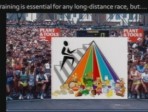 00:11:00
00:11:00
Body Fuel for Long Distances
In my geoset project I will be discussing the effects of nutrition in long distance endurance. Topics include saturating carbohydrate stores before a race, the Krebs (citric acid) cycle, the effects of dehydration and hyponatremia, and replenishing y....
More details | Watch now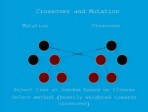 00:10:00
00:10:00
Genetic Programming
Genetic Programming is an artifical intelligence technique based off of natural selection. A generation of programs is generated, then tested using a fitness function. After that successful programs are altered and replicated successively until a d....
More details | Watch now 00:11:00
00:11:00
The Science of Addiction
This presentation deals with common additives in cigarettes, including nicotine, and how these affect your body.
More details | Watch now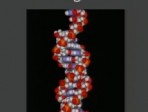 00:08:00
00:08:00
Pharmaco-genomics
This is a brief presentation discussing the emerging field of pharmaco-genomics. It explains how understanding the human genome can lead to better drug therapy in the future including tailor-made drugs for individuals.
More details | Watch now 00:06:00
00:06:00
The Science of Love
A brief look into the physical, biological, chemical and behavioral attributes that humanity shares with other members of the animal kingdom focusing on studies done on Jamaican dancers, Belding's ground squirrels, human MHC and others.
More details | Watch now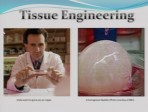 00:08:00
00:08:00
Tissue Engineering
Mariah Michael discusses the burgeoning field of tissue engineering and the research being done at Wake Forest University under Dr. Anthony Atala. Each year, thousands of patients die while waiting for an organ transplant. With this technology, patie....
More details | Watch now 00:11:00
00:11:00
Genetically Modified Organisms
A brief overview of genetically modified organisms and their effect on the global population.
More details | Watch now 01:17:00
01:17:00
Mammalian biodiversity: past, present, future?
Beautiful and charismatic, mammals are biodiversity icons. But a quarter of mammalian species are now threatened with extinction, as ecosystems reel under the impact of a growing and ever more demanding human population. This lecture explores the his....
More details | Watch now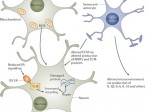 01:06:00
01:06:00
Three score years and then? The new biology of ageing
Ageing is the single greatest challenge facing our society today. Recent breakthroughs have demonstrated that it is possible to combine a long life with the absence of age-related disease. Scientists at the forefront of this research will explain the....
More details | Watch now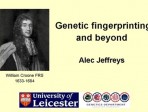 01:07:00
01:07:00
Genetic fingerprinting and beyond
Professor Jeffreys will describe how DNA typing can be used to solve casework and will review the latest developments, including the creation of major national DNA databases that are proving extraordinarily effective in the fight against crime.
More details | Watch now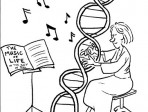 01:12:00
01:12:00
The Music of Life
This event at Sheffield University formed part of a series on Arts-Science Encounters. Stories from The Music of Life related by Denis Noble are interwoven with performances of relevant pieces of classical guitar music by the world-class performer, C....
More details | Watch now 01:00:00
01:00:00
The great ideas of biology
Three of the ideas of biology are the gene theory, the theory of evolution by natural selection and the proposal that the cell is the fundamental unit of all life. A fourth idea is that the organization of chemistry within the cell provides explanati....
More details | Watch now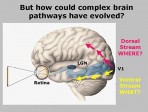 01:00:00
01:00:00
Plasticity of the brain: the key to human development.
How do our genes program the complexity of our brains? Why is human culture so much richer than that of the Great Apes? And how has human cognitive achievement continued to accelerate, when our genetic makeup has changed very little over the past 100....
More details | Watch now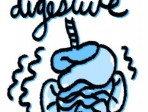 00:11:00
00:11:00
The breakdown of macro-nutrients
Presentation on the breakdown of macro-nutrients. The chemical decomposition of macronutrients, which includes carbohydrates, proteins, and lipids.
More details | Watch now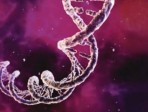 00:11:00
00:11:00
Mitochondrial DNA Testing
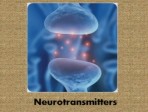 00:12:00
00:12:00
Neurochemistry
A presentation on neurochemistry - the effects of drugs and nutrition are also discussed.
More details | Watch now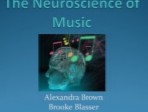 00:09:00
00:09:00
The Neuroscience of Music
 01:02:00
01:02:00
Thinking like a vegetable: how plants decide what to do
Plants monitor a wide range of information from their surrounding environment. They combine information of multiple sorts, and respond in an appropriate way. In plants there is no brain, and the information processing is distributed across the plant ....
More details | Watch now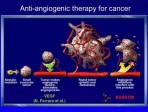 01:12:00
01:12:00
Brain development and brain repair.
The human brain is made up of close to a trillion nerve cells (or neurons), each of which makes connections with, on average, hundreds of other nerve cells, to form the complex neuronal circuits that control all brain activities, including perception....
More details | Watch now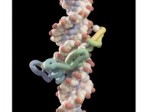 01:08:00
01:08:00
Engineered zinc finger proteins and gene expression
It has long been the goal of molecular biologists to design DNA binding proteins for the specific control of gene expression. The zinc finger design, discovered by Sir Aaron Klug 20 years ago, is ideally suited for such purposes, discriminating betwe....
More details | Watch now 01:12:00
01:12:00
Deciphering disease: cells and disruption of their communication
The human body may seem to be no more than a bundle of tissues and organs, yet the cells these are made from are capable of interacting, communicating and performing complex tasks. Our cells' capacity to interact in this way enables humans to adapt t....
More details | Watch now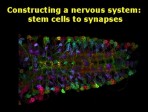 00:58:00
00:58:00
Stem Cells to Synapses
One of the goals of research in neurobiology is the repair and regeneration of neurons after damage to the brain or spinal cord. Before we can understand how to repair the nervous system we must first learn how the nervous system is put together.
More details | Watch now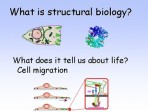 01:03:00
01:03:00
Structure and the living cell
In this lecture Iain Campbell will discuss methods of studying the structure of molecules and cells and how they have advanced in the 350 years since early microscopes gave the first glimpse of single cells. He will show how modern methods are allowi....
More details | Watch now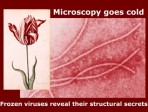 01:05:00
01:05:00
Microscopy goes cold: secrets of frozen viruses
Viruses are a major cause of death and disease. Too small to be seen by light microscopy, they were first visualised about 50 years ago by electron microscopy. Dr. Crowther describes his work on the development of the methods and illustrates how he h....
More details | Watch now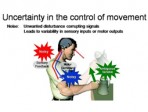 01:08:00
01:08:00
The Puppet Master: How the brain controls the body
The effortless ease with which humans move our arms, our eyes, even our lips when we speak masks the true complexity of the control processes involved. Professor Daniel Wolpert explains how the brain deals with this and can perform optimally in the p....
More details | Watch now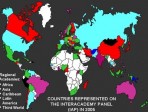 01:19:00
01:19:00
Beyond the human genome project
Dr Lander and his colleagues have developed many of the key tools and generated many of the key information resources for modern mammalian genomics. Their work includes mapping and sequencing of the human, mouse, and other genomes. He was elected a m....
More details | Watch now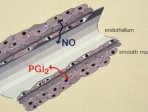 01:09:00
01:09:00
Adventures in vascular biology
Thirty years ago it was thought that the endothelium, a layer of thin, flat cells that line the interior surface of blood vessels was inert. However, major discoveries since then have demonstrated that it is a highly metabolic organ involved in maint....
More details | Watch now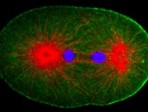 01:05:00
01:05:00
Genes, worms and the new genetics
A surprising finding over the past 20 years is that all animals have many of the same genes and that they use them in similar ways to grow and develop. These similarities mean that much of what is learned about what genes do in simple animals such as....
More details | Watch now 01:13:00
01:13:00
Magnetic brain stimulation and brain function?
Like his nineteenth century contemporaries David Ferrier tried to reveal cerebral localisation of function by direct electrical stimulation of the exposed brain of animals. With some notable exceptions the results were disappointing and confined to t....
More details | Watch now